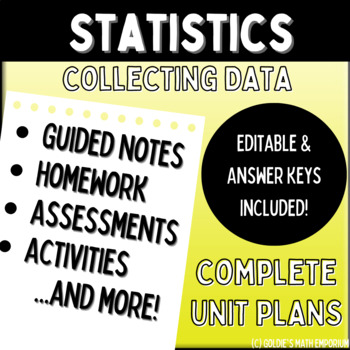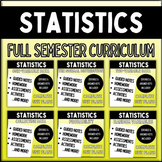Statistics: Collecting Data
- Zip
What educators are saying
Also included in
- Statistics: Full Curriculum This is the FULL CURRICULUM bundle for my regular-level, Statistics course. If you are looking for my full curriculum for AP Statistics, follow the link here. This full curriculum is six units long and lasts 1 semester, approximately 90 school days. The following units arPrice $99.00Original Price $120.00Save $21.00
Description
Statistics
Unit 4: Collecting Data
Complete Unit Bundle that teaches about observational studies, sample surveys, sampling, experiments, ethics, and more!
Welcome! This is the complete unit plan for the fourth unit in my regular-level Statistics class (if you are interested in the AP Statistics Collecting Data unit plans, check out my listing here)
Included in this resource:
- 5 complete sets of student-guided notes (answer keys included)
- 5 homework problem sets + complete test review (answer keys included)
- 2 assessments – quiz and test (answer keys included)
- 2 in-class review PowerPoint presentations
- 3 activities
- 1 project
- Suggested pacing and learning targets
All of the resources are 100% editable, to modify to fit your classroom needs. The zip folder includes the Word document, which you have permission to edit completely. The PDF version and answer keys are included for your convenience. There are also PowerPoint presentations for some of the review documents.
I teach this course without a textbook, so everything that is provided here, can be used without supplementation.
******************************************************************************
The student-friendly learning targets for this unit are:
- Students will be able to identify between an observational study and an experiment.
- Students will be able to identify the type of sampling method (simple random sample, stratified, cluster, systematic, multistage, and convenience), given a description of a study.
- Students will be able to construct a simple random sample using technology and a table of random digits.
- Students will be able to identify sources of bias in a sampling method.
- Students will be able to identify the components of a well-designed experiment.
- Students will identify and compare experimental designs.
- Students will be able to understand the ethical concerns surrounding experimental procedures.
The Common Core Math Standards covered in this unit are:
- IC.A.1: Understand statistics as a process for making inferences about population parameters based on a random sample from that population.
- IC.B.3: Recognize the purposes of and differences among sample surveys, experiments, and observational studies; explain how randomization relates to each.
******************************************************************************
My regular level Statistics course includes the following units:
Unit 2 – The Normal Distribution
Statistics: Full Semester Curriculum Bundle (Units 1 – 6)
Unit 7 – Sampling Distributions
Unit 8 – Confidence Intervals (Coming Soon!)
Unit 9 – Hypothesis Testing (Coming Soon!)
Unit 10 – Comparing Two Populations (Coming Soon!)
Unit 11 – Chi-Square Distributions (Coming Soon!)
******************************************************************************
Q: How is this different from my AP Statistics Unit 3 Unit Plans?
A: My AP Stat Unit 3 plans follow the AP Stat CED, which covers data collection and experiments in 11 days. My regular level Statistics course covers the same material, but with smaller sections of notes, smaller assessments, more time for activities, and fewer college-level questions.
Q: Can I use your AP Statistics materials in my on-level (regular level) Statistics course?
A: Absolutely! These unit plans fit a semester-long course in Statistics. My AP Statistics unit plans would fit perfectly for a year-long Statistics course, with a modified pacing schedule. You can check out the full curriculum here. If you have more questions about the differences and want some help deciding what would work best in your class, please feel free to reach out via email or Q&A on TPT.
******************************************************************************
If you need extra explanations or additional guidance, I would love to help!! Contact me at goldiesmathemporium[at]gmail.com for any questions or samples.
I want to provide the best possible resources to help other teachers out! You will be notified of any future updates and additions to this product and it will be free of charge. Your support is important and I thank you for allowing me to continue doing what I love to do.
Note: I am not affiliated with nor endorsed by any textbook or other curriculum provider. I am a classroom teacher who creates curriculum materials to help other teachers.
© Goldie’s Math Emporium, LLC
This work is bound by copyright laws and editing (beyond your own classroom use), selling, redistributing, or posting all or part of these documents on the Internet is strictly prohibited. Violations are subject to the Digital Millennium Copyright Act.



